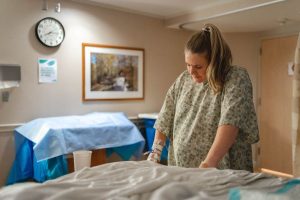Week 28
This is the first week of the third trimester and the week you may start to notice things like leg cramps and hemorrhoids. Leg cramps can be caused by the extra weight you are carrying, swelling, lack of exercise, and certain vitamin or mineral deficiencies. A great way to combat this is to walk! (1) Walking can help keep blood flowing and it does not only help with leg cramps. Walking during pregnancy can also help with back pain (2), improves sleep, and reduces constipation. (3) Constipation is another common side effect of pregnancy. By the third trimester, you may start to notice small amounts of bright red blood in your stool. This is normally due to hemorrhoids, which can be caused by constipation or by the uterus putting pressure on your veins. (1)
Week 29
You may have already experienced heartburn in your pregnancy, but it’s during the 3rd trimester when it can get worse. This is due to the hormone progesterone which relaxes muscles including your digestive tract. (4) Some ways to combat heartburn are sleeping propped up, avoiding eating late at night, and avoiding spicy foods.
Week 30
This week you may start to notice that your belly button has become an “outie” if it wasn’t already. This can happen due to the pressure in your abdomen that will push the belly button out. It is usually painless but you may notice that your belly button is sensitive to touch. (5) If it does become sensitive to touch, you can put a bandage over your belly button so your clothes will not touch it. And it’s most likely that your belly button will go back to normal after birth. (6)

Week 31
This week, some women will start to feel Braxton Hicks contractions if they haven’t earlier in their pregnancy. These are not the same as labor contractions. The differences are Braxton Hicks contractions only last about 30 seconds, are not consistent, and usually do not hurt. Labor contractions will occur more consistently as time goes on, will last longer, and will become painful as they intensify. (7)
Week 32-Birth
There are no significant changes specific to each week from weeks 32 to 40. But some symptoms you may experience from now until you give birth are “lightning crotch,” wrist pain, swollen labia, and increased pelvic pain.
You may or may not have heard the term “lightning crotch” to describe sharp pains some women have in the pelvic area later in pregnancy. Some women have described it as a pins and needles sensation in the groin or thigh area. It is believed that this sensation is from the baby dropping into your pelvis which presses on nerves around the cervix. The sensations usually only last a few seconds and are not consistent. (8)
Some women can be more prone to carpal tunnel (wrist pain) during pregnancy due to swelling in the arms and hands. Carpal tunnel occurs when a nerve in the hand is being pressed upon and it usually flares up later in pregnancy. If you do experience this, you may need to talk to your doctor or midwife about different ways to decrease swelling and increase strength in your wrist. (9)
As you get closer to the end of your pregnancy, the baby will begin to drop into your pelvis to prepare for their exit. This can cause pain and discomfort in the pelvic area as pressure begins to increase. You may even notice that your labia (lips that surround the vagina) start to swell and become darker. (10) You may consider getting a pregnancy band or belt if you are not finding relief from pelvic pain. These can provide support for the lower abdomen and relieve some of that pressure. (11)
Approaching Birth
Technically, 39 weeks is considered full term but you can go into labor anytime after 37 weeks. (12) As your body is preparing for labor, your cervix will start to dilate, soften, and become thin. For some women, these cervical changes don’t begin until they are in labor. But for others, they can begin days or weeks before they are in active labor. (12) Another sign that can indicate labor is approaching is your water breaking. This is when the amniotic sack (where the baby has been living since conception) ruptures and fluid starts leaking from your vagina. Sometimes your water can break before labor starts but it usually happens when labor is already in progress. (13)

You are now on your way to giving birth and finally meeting your baby! I hope these blog posts have given you an idea of what to expect during the 40 weeks of pregnancy. If you are experiencing any symptoms that don’t feel normal or you have questions, don’t hesitate to reach out to your healthcare provider.

If you have any questions or concerns, please contact;
Nurturing Center of Lubbock
3303 66th Street
Lubbock, TX 79413
Phone: 806-780-6853 (available 24 hours)
Text: 806-317-4480
Email: info@nurturinglife.org
Resources
- https://www.babycenter.com/pregnancy/week-by-week/28-weeks-pregnant
- https://lovelace.com/news/blog/health-benefits-walking-during-pregnancy#:~:text=Walking%2C%20especially%20in%20the%20last,levels%20as%20well%20as%20mood.
- https://www.annandaleobgyn.com/news/the-benefits-of-walking-during-pregnancy/
- https://www.babycenter.com/pregnancy/week-by-week/29-weeks-pregnant
- https://www.babycenter.com/pregnancy/week-by-week/30-weeks-pregnant
- https://health.clevelandclinic.org/why-do-some-womens-belly-buttons-pop-out-during-pregnancy/
- https://www.babycenter.com/pregnancy/week-by-week/31-weeks-pregnant
- https://www.babycenter.com/pregnancy/week-by-week/32-weeks-pregnant
- https://www.babycenter.com/pregnancy/week-by-week/33-weeks-pregnant
- https://www.babycenter.com/pregnancy/week-by-week/33-weeks-pregnant
- https://www.babycenter.com/pregnancy/week-by-week/36-weeks-pregnant
- https://www.babycenter.com/pregnancy/week-by-week/37-weeks-pregnant
- https://www.babycenter.com/pregnancy/week-by-week/40-weeks-pregnant
Marlee Henn, RN
Marlee has been a nurse for two years and currently works in a functional medical clinic and part time in a long term acute care center. She has a passion for natural living, women’s health, and education.

Recent Comments